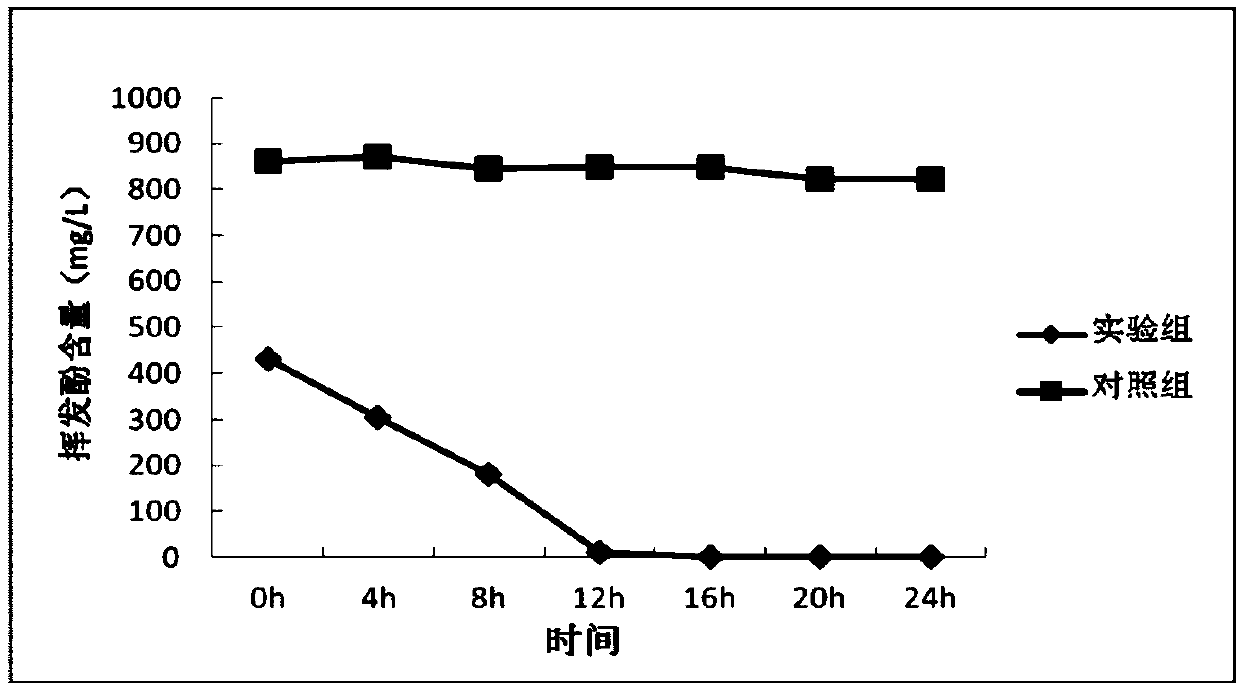Biological phenol-reducing microbial inoculum and application method thereof
A phenolic inoculant and biological technology, applied in the field of biological phenol-reducing inoculants, can solve problems such as difficulty in improving and restricting, and achieve the effects of reducing production and use costs, fast degradation, and convenient transportation and storage.
- Summary
- Abstract
- Description
- Claims
- Application Information
AI Technical Summary
Problems solved by technology
Method used
Image
Examples
Embodiment 1
[0052] The acquisition of embodiment 1 bacterial strain
[0053] Sampling was taken from the soil near the phenol-containing sewage treatment system, and a total of 30 strains of single bacteria were isolated and screened, of which 14 strains had the ability to degrade volatile phenols;
[0054] From the 14 strains with the ability to reduce phenols, by increasing the concentration of phenol and studying its genetic stability and scope of application, two strains with high efficiency in degrading volatile phenols, easy to cultivate and stable inheritance were screened;
[0055] The inventors performed 16SrDNA sequencing on them, and their nucleotide sequences are shown as Seq ID No: 1 and Seq ID No: 2 respectively, which are the complete sequence of 16SrDNA of the strain. The measured 16SrDNA sequences were compared by BLAST, and at the molecular level, they were identified as Alcaligenes spp and Bacillus cereus, respectively,
[0056] The inventor named them YJY18-10 and YJY...
Embodiment 2
[0058] The acquisition of embodiment 2 bacterial powder
[0059] Utilize above-mentioned bacterial strain to obtain bacterial powder, the obtaining method of bacterial powder is as follows:
[0060] (1) Fermentation culture: Inoculate Alcaligenes and Bacillus cereus in the sterilized fermentation medium to obtain their respective bacterial liquids; at a temperature of 28-30°C, culture the fermenter until dissolved oxygen rises, pH falls;
[0061] (2) Preparation of bacterial powder: after centrifuging the fermented liquid, add auxiliary materials and mix evenly, and obtain solid bacterial powder after drying.
[0062] The more specific steps for the preparation of the two bacterial powders are as follows:
[0063] 1) Strain activation: On a sterile operating bench, take 1-5 μL of frozen-preserved Alcaligenes and Bacillus cereus in a test tube containing LB liquid medium, and culture at 28-32°C, 130-180rpm for 18-24h ;
[0064] 2) Seed preparation: transfer the activated st...
Embodiment 3
[0073] The utilization of embodiment 3 composite bacterial agents 1
[0074] The bacterial powder obtained in embodiment 2 needs to be activated in advance when used, and the activation method is:
[0075] Bacteria powder is inoculated in nutrient salts for activation according to the weight-to-volume ratio of 1-5g / L. The activation conditions are: 28-32°C, 130-180rpm shaker culture for 1-2h for activation.
[0076] Wherein the composition of nutrient salt solution is as follows: by weight:
[0077] 0.3-0.5 parts of dipotassium hydrogen phosphate; 0.01-0.02 parts of ferrous sulfate; 0.1-0.3 parts of calcium chloride; 0.3-0.5 parts of potassium dihydrogen phosphate; 0.1-0.5 parts of magnesium sulfate; 0.2 parts of sodium chloride; 0.5-1 parts of ammonium nitrate, 97-98.6 parts of demineralized water.
[0078] In the above activated salt solution, 300 mg / L of phenol was added in proportion as the only carbon source for activation treatment;
[0079] 1. Treated water quality: ...
PUM
 Login to View More
Login to View More Abstract
Description
Claims
Application Information
 Login to View More
Login to View More - R&D
- Intellectual Property
- Life Sciences
- Materials
- Tech Scout
- Unparalleled Data Quality
- Higher Quality Content
- 60% Fewer Hallucinations
Browse by: Latest US Patents, China's latest patents, Technical Efficacy Thesaurus, Application Domain, Technology Topic, Popular Technical Reports.
© 2025 PatSnap. All rights reserved.Legal|Privacy policy|Modern Slavery Act Transparency Statement|Sitemap|About US| Contact US: help@patsnap.com

